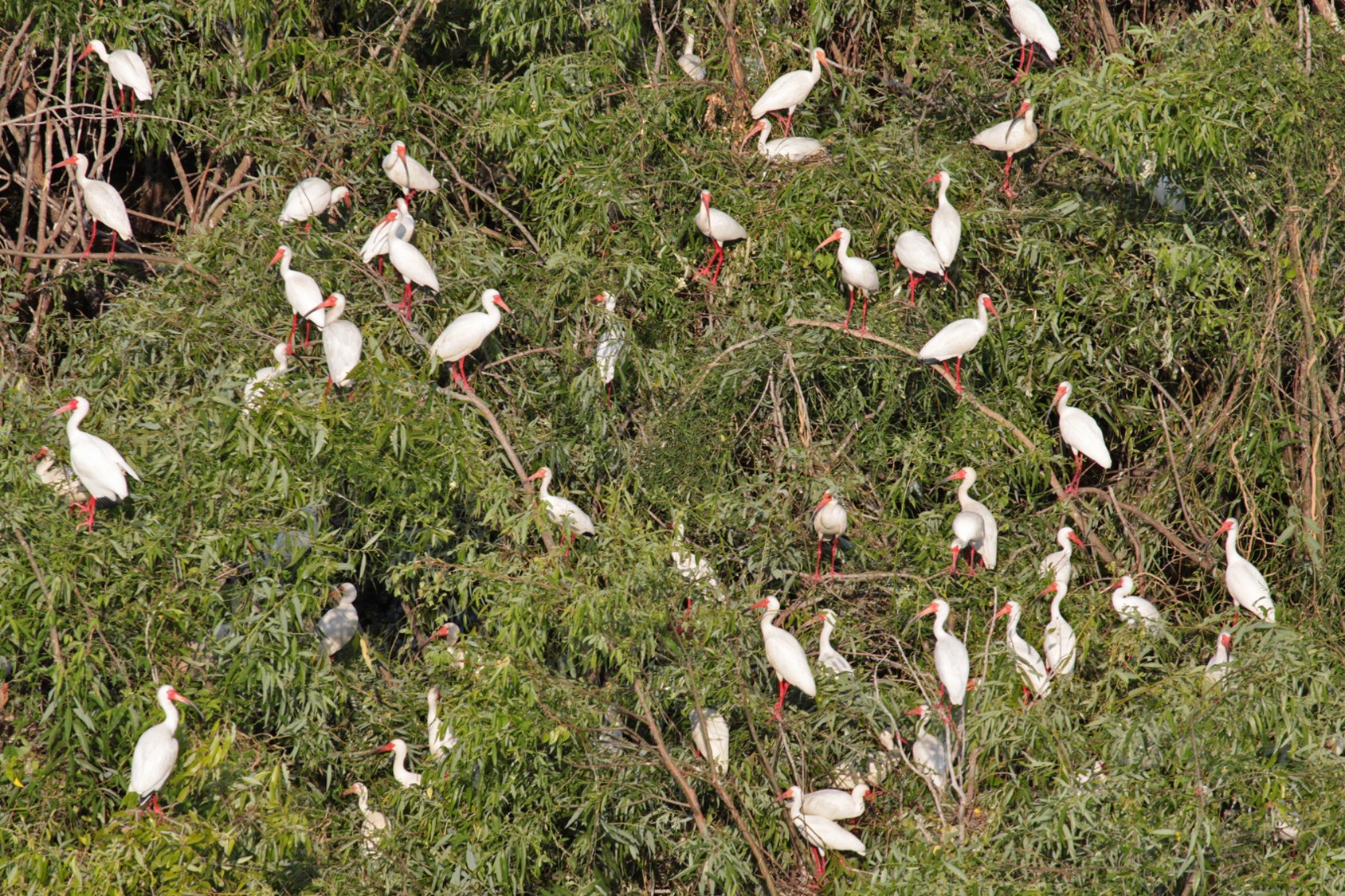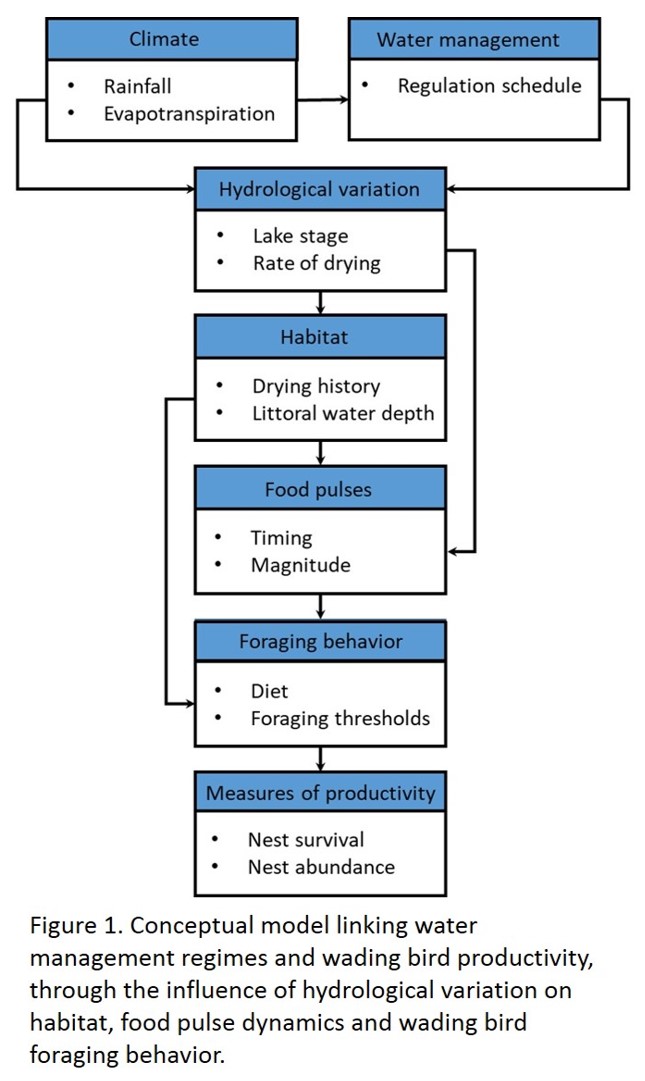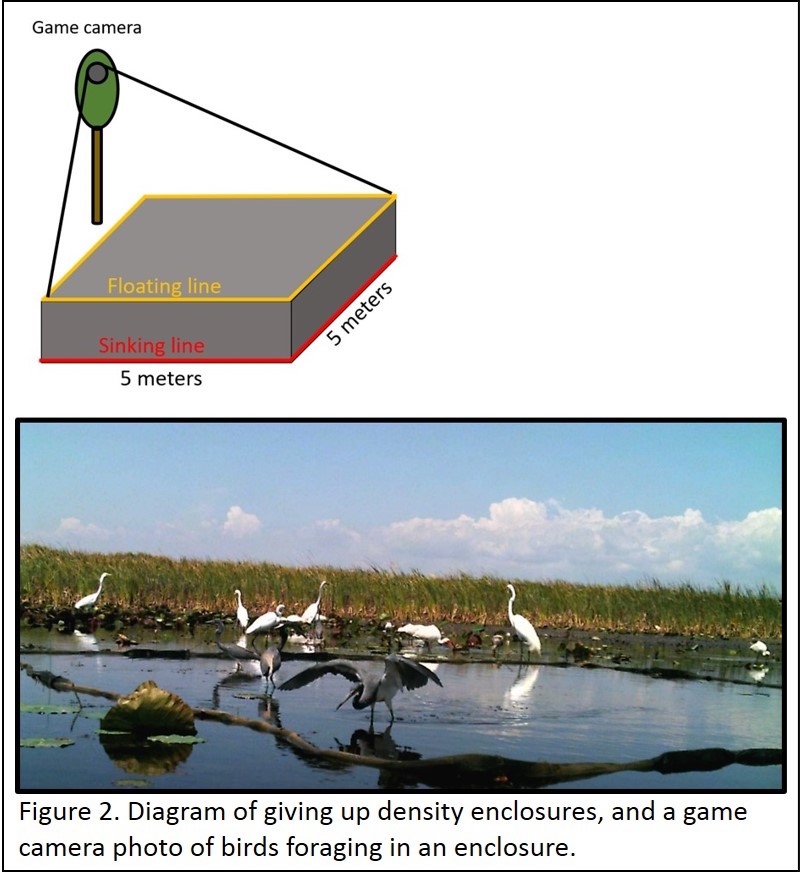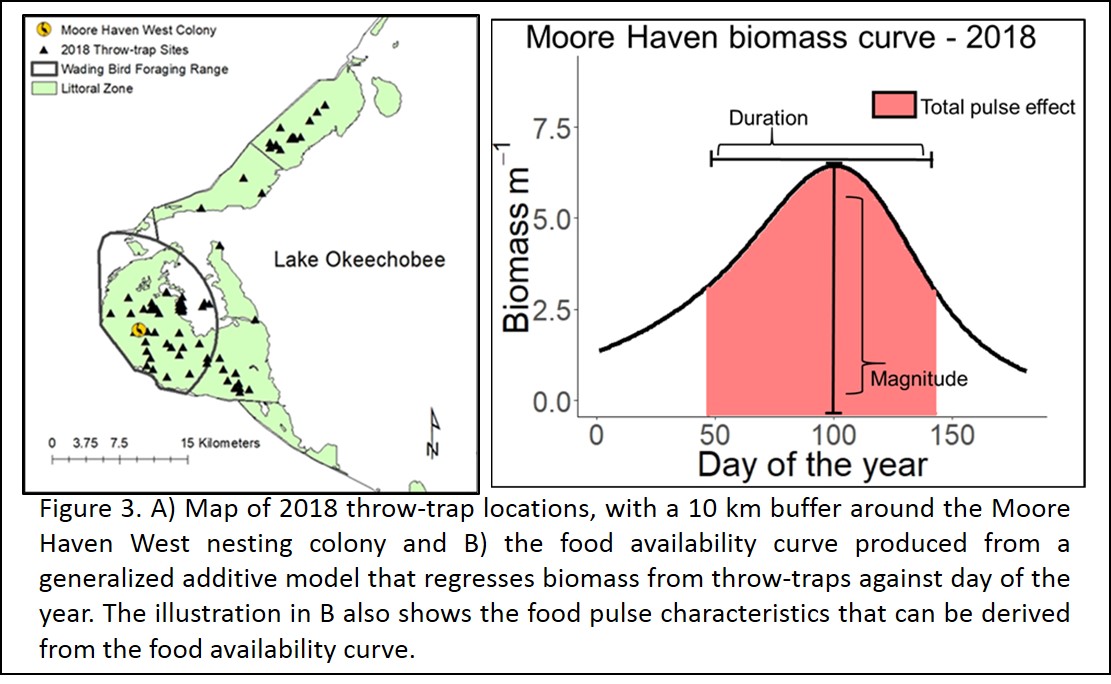
 Millions of people, businesses and protected wetland ecosystems rely on Lake Okeechobee as a water source. Thus, optimizing water management at Lake Okeechobee is imperative to the success of Everglades restoration. Efforts to develop future water management strategies and plan restoration projects within the watershed are currently underway, yet there is little understanding of how small fish and wading birds, two important indicator taxa at the lake (Havens and Gawlik 2005), respond to hydrological patterns. This proposal seeks to address knowledge gaps and to develop tools to predict indicator responses to future hydrological scenarios. Using datasets that span 9 years, I will develop a model to explain variation in fish biomass availability within the foraging ranges of wading bird colonies, and to quantify the effect of food pulse dynamics on wading bird survival. Quantifying the relationships among hydrological variation, small fish, and wading birds, over many hydrologically distinct seasons, will provide managers with better tools to predict ecosystem responses to water management in Lake Okeechobee’s littoral zone.
Millions of people, businesses and protected wetland ecosystems rely on Lake Okeechobee as a water source. Thus, optimizing water management at Lake Okeechobee is imperative to the success of Everglades restoration. Efforts to develop future water management strategies and plan restoration projects within the watershed are currently underway, yet there is little understanding of how small fish and wading birds, two important indicator taxa at the lake (Havens and Gawlik 2005), respond to hydrological patterns. This proposal seeks to address knowledge gaps and to develop tools to predict indicator responses to future hydrological scenarios. Using datasets that span 9 years, I will develop a model to explain variation in fish biomass availability within the foraging ranges of wading bird colonies, and to quantify the effect of food pulse dynamics on wading bird survival. Quantifying the relationships among hydrological variation, small fish, and wading birds, over many hydrologically distinct seasons, will provide managers with better tools to predict ecosystem responses to water management in Lake Okeechobee’s littoral zone.
 A resource pulse is any infrequent, large-magnitude increase in resource availability over a short duration (Yang et al. 2008). Pulses affect biomass and productivity across trophic levels, and therefore can elicit system-wide responses that involve many consumer-resource interactions (Holt 2008; Odum et al. 1995). Theory predicts that species living in pulsed systems should carry traits that allow them to exploit pulses (Holt 2008; Junk et al. 1989), particularly in systems like the Everglades where pulses occur predictably during the dry season, and last long enough for individuals to obtain enough resources to increase their fitness. However, even where pulses are predictable, they vary in timing, magnitude and duration. Differences in consumer traits, such as body size, niche breadth and phenology determine how a species responds to pulse characteristics (Schwinning and Ehleringer 2010; Venner et al. 2011; Yang et al. 2010). A decline in Everglades wading bird populations over the past century has been attributed to human impacts on hydrological regimes, which altered the location, timing, and magnitude of food pulses for nesting wading birds (Frederick et al. 2009; Ogden et al. 2014). Accordingly, efforts to restore wading bird populations in the Everglades are primarily focused on maintaining hydrological regimes that produce food pulses. The resource pulse concept is a useful construct for examining wading bird responses to hydrologically driven food pulses, since it seeks to explain the influence of resource inputs on consumers (Yang et al. 2008).
A resource pulse is any infrequent, large-magnitude increase in resource availability over a short duration (Yang et al. 2008). Pulses affect biomass and productivity across trophic levels, and therefore can elicit system-wide responses that involve many consumer-resource interactions (Holt 2008; Odum et al. 1995). Theory predicts that species living in pulsed systems should carry traits that allow them to exploit pulses (Holt 2008; Junk et al. 1989), particularly in systems like the Everglades where pulses occur predictably during the dry season, and last long enough for individuals to obtain enough resources to increase their fitness. However, even where pulses are predictable, they vary in timing, magnitude and duration. Differences in consumer traits, such as body size, niche breadth and phenology determine how a species responds to pulse characteristics (Schwinning and Ehleringer 2010; Venner et al. 2011; Yang et al. 2010). A decline in Everglades wading bird populations over the past century has been attributed to human impacts on hydrological regimes, which altered the location, timing, and magnitude of food pulses for nesting wading birds (Frederick et al. 2009; Ogden et al. 2014). Accordingly, efforts to restore wading bird populations in the Everglades are primarily focused on maintaining hydrological regimes that produce food pulses. The resource pulse concept is a useful construct for examining wading bird responses to hydrologically driven food pulses, since it seeks to explain the influence of resource inputs on consumers (Yang et al. 2008).
The Everglades is a subtropical pulsed wetland where water levels fluctuate according to seasonal rainfall patterns, thereby providing a highly dynamic habitat for resident plants and animals. This is reflected in the life histories of wading birds, which reproduce during the dry season, when low rainfall coupled with high evapotranspiration rates concentrate fish and aquatic macroinvertebrates into small pools, creating a resource pulse that wading birds rely on to meet energetic demands of nesting. A primary goal of Everglades restoration is to maintain large nesting populations of wading birds, thus understanding how birds respond to resource availability dynamics is important for planning future Everglades restoration scenarios.
Wading bird populations are desirable indicators for Everglades restoration because they nest in large, mixed-species colonies, making them relatively easy to monitor, they are sensitive to changes in the hydrologic regimes that drive secondary production (Hafner et al. 1993; Kingsford et al. 1999; Kushlan 1986), and they are aesthetically appealing to the public (Frederick and Ogden 2003; Frederick et al. 2009; Ogden et al. 2014; RECOVER 2004). Over the past century, Everglades wading bird populations declined rapidly (Crozier and Gawlik 2006; Frederick and Ogden 2003; Frederick et al. 2009) and have only recently exhibited signs of recovery (Frederick et al. 2019). In general, the greatest factor limiting wading bird nest abundance and survival is food availability, which is primarily regulated by water depth and prey densities (Frederick and Spalding 1994; Gawlik 2002; Kushlan 1986). The degree to which food availability limits nest abundance also depends on species-specific traits, such as diet specialization, foraging behavior, movement patterns, and phenology (Gawlik 2002; Klassen et al. 2016).
The relationships between hydrological variation, prey populations, and wading bird responses have been researched extensively in the Everglades, and are represented in the conceptual model in figure 1. This has resulted in a deep understanding of how water-level fluctuations affect key species across herbaceous marshes of the vast Everglades Protection Area (Water Conservation Areas and Everglades National Park). Importantly, it has also resulted in predictive tools that can be used to simulate responses of several taxonomic groups, including small fish and wading birds, to future restoration scenarios in these regions (e.g. Beerens et al. 2017). Such models are in high demand given the importance of small fish and wading bird performance measures in assessing restoration performance, yet no comparable models exist for Lake Okeechobee.
 I will develop statistical models that can be used to forecast species-specific nest abundances under future hydrological scenarios. I used a model selection approach to test hypotheses regarding the numerical responses of nesting Great Egrets (Ardea alba), Snowy Egrets (Egretta thula), and White Ibis (Eudocimus albus) and found important differences among species. For instance, my results support hypotheses posed by Klassen et al. (2016), that wading birds with longer nesting periods require more habitat to become available during the nesting season, whereas those with shorter nesting periods can benefit more from high prey concentrations. However, my models demonstrate that local habitat availability can also be limiting for species with shorter nesting periods.
I will develop statistical models that can be used to forecast species-specific nest abundances under future hydrological scenarios. I used a model selection approach to test hypotheses regarding the numerical responses of nesting Great Egrets (Ardea alba), Snowy Egrets (Egretta thula), and White Ibis (Eudocimus albus) and found important differences among species. For instance, my results support hypotheses posed by Klassen et al. (2016), that wading birds with longer nesting periods require more habitat to become available during the nesting season, whereas those with shorter nesting periods can benefit more from high prey concentrations. However, my models demonstrate that local habitat availability can also be limiting for species with shorter nesting periods.
I designed giving up density experiments so that they could be performed in the littoral zone during the breeding season. Prey densities in the littoral zone were estimated using throw traps so that I could quantify the correlation between GUD estimates and littoral prey densities. The objective is to develop a methodology for using GUD experiments as a rapid behavioral assessment of prey availability in the littoral zone.
Since 2011, the Gawlik lab has sampled nestling diets of several wading bird species at nesting colonies throughout south Florida. The duration of the study is unique among wading bird diet studies and it offers an opportunity to examine wading bird diets across a large range of habitats and hydrological conditions. I will conduct a comprehensive diet analysis of herons and egrets (Ardeidae) in south Florida over this period, and compare to historical records of diet in the region.
Using 2011-2019 prey availability and nest survival data, I will examine the effect of food pulse dynamics on daily nest survival rates of three wading bird species with different nest phenology and foraging strategies. Three predictors will represent food pulse dynamics: duration, magnitude, and total pulse effect (Figure 3). These predictors will be scaled by the amount of habitat available within the foraging range, throughout the breedingseason.
